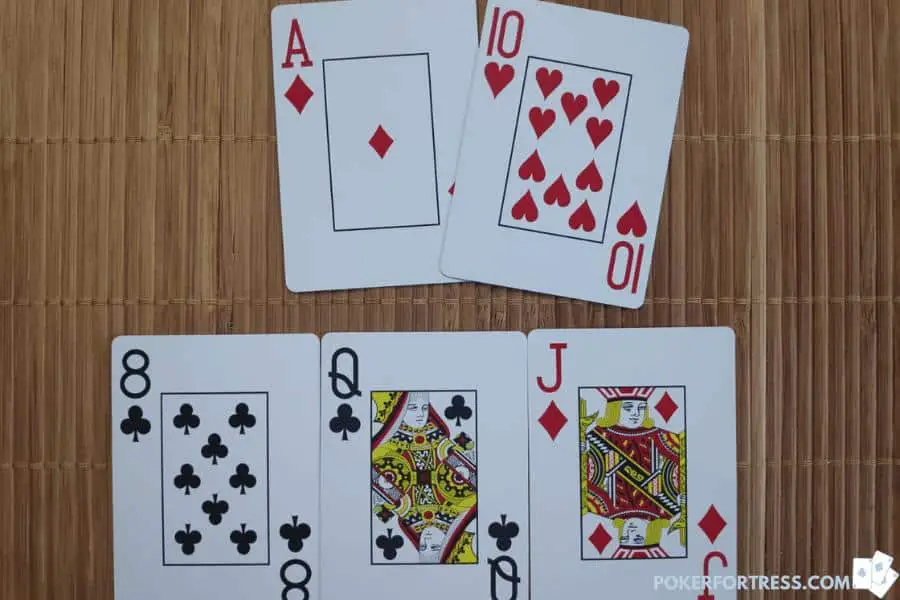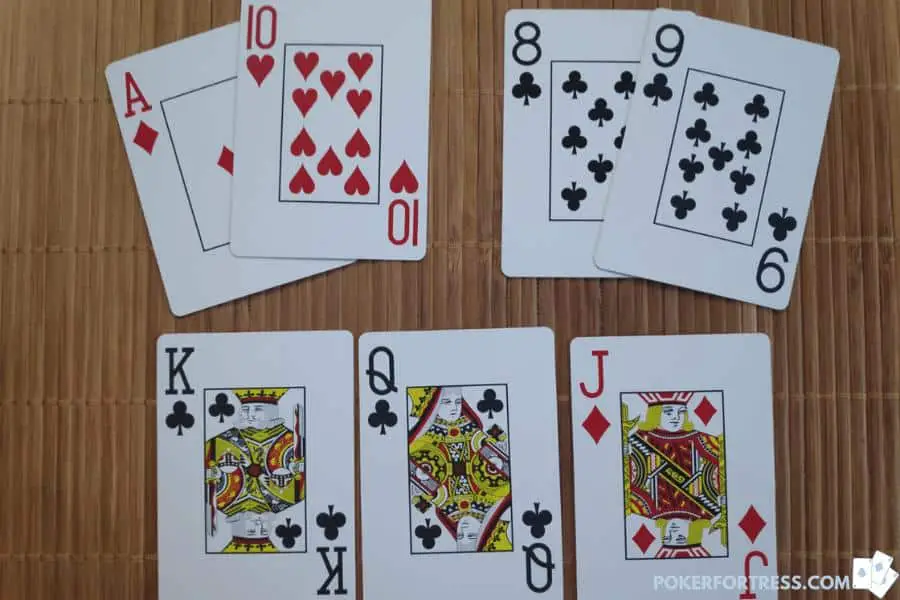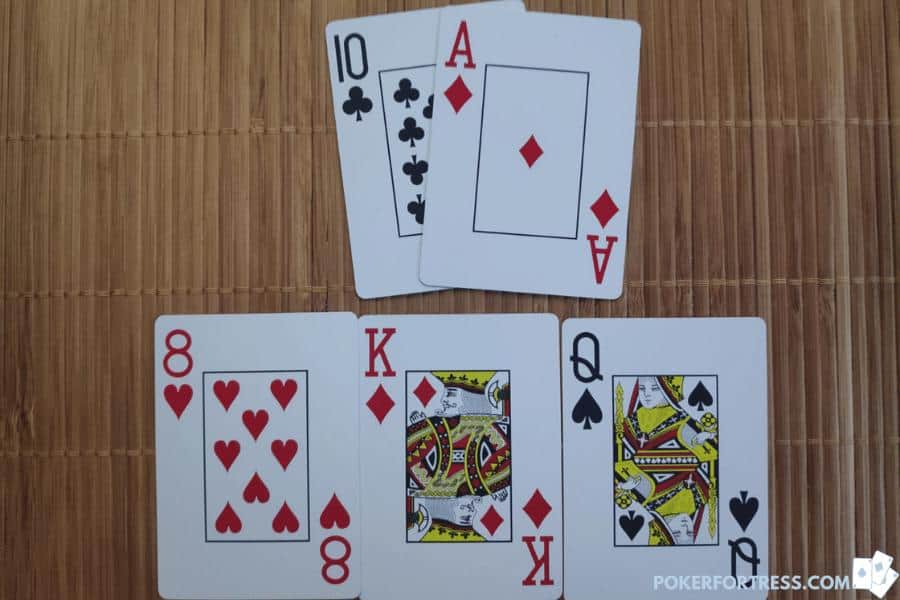Broadway is the highest possible combination for a straight—rainbow TJQKA. Sometimes, we call it ace-high straight, which is a dominant hand in many situations. If you only flop a 4-card hand, we call it a Broadway draw, and it can be quite challenging to play, even for professionals.
Broadway draw is a 4-card hand that only needs one card to complete an ace-high straight. An example of a Broadway draw is pocket T♣A♦ with a flop of 7♥ K♦ Q♠. Turning a jack of any suit will give you the nuts, but it’s a tricky hand, and many players don’t play it properly.
There’s a wide range of possible plays that you’ll encounter when you have a Broadway draw, and most of them will rely on controlling the pot size. We’ll cover all of these in great detail, including a few tips that you can use when you have a broadway draw.

Broadway in a Glance
Broadway, the heart of the American commercial theatrical industry, located in Manhattan, New York, also refers to the highest possible straight in any poker game. Since a card suit doesn’t matter in straights, even a rainbow ace-high straight is a broadway.
A Broadway beats any straight in the same game when ranking straight hands, but it’s still weaker than flushes, fullhouses, 4 of a kind, straight flushes, and royal flush. Given its crucial strength and weakness in poker’s hand ranking, broadway often becomes a death trap for many players. Here’s an example of a potentially devastating broadway straight:
- Hero draws T♥ A♦
- Villain draws 9♣ 8♣
- Flop of Q♣ J♦ K♣
In this scenario, the hero already has the nuts by the flop. However, there’s a potential for the villain to draw a flush. One club is all it takes for this Broadway to turn into a death trap. With 9 outs, there’s a considerable 34.97% chance that the turn or river card will complete the flush.

It’s a dominant 5-card hand combination that is enough to see the river and definitely we are happy to reraise and get it in on the flop. Unfortunately, any flush, full house, or a straight flush hand that ranks higher than a straight can take down a broadway straight, making it a dangerous situation for many players.
Broadway Draw in a Glance
On the other hand, a broadway draw is a 4-card hand that can turn into a Broadway or an ace-high straight. Here’s the best example of a Broadway draw:
- Our hand of T♣ A♦
- Flop of 8♥ K♦ Q♠
In this scenario, the player only needs a jack (any suit) by the turn or river to complete his hand. We call it an inside broadway draw because it’s missing the middle part of the combination (T♣ X Q♠ K♦ A♦). It has 4 outs, so there’s a 16.47% chance that the turn or river card will draw a jack.
Almost every player is familiar with this hand, and when playing low-stakes games, a broadway draw is strong enough to see the river. It could even be enough for one of your friends to 3bet this hand as a semi bluff and apply pressure, but it actually puts him in a difficult spot. The chance for him to complete a 5-hand card is a bit low, and it goes even further down to 8.70% to hit it from turn to river. It’s a meager percentage for you to even flat call a bet on turn.
Depending on your opponents’ ranges, a broadway draw may be strong enough to see the river, but calling a 3bet at the turn with it is a losing strategy. A Broadway draw is a relatively strong hand, but in our example, a villain with 8♦ Q♦ can be dangerous for the hero. It’s one of the reasons many poker players consider it one of the most complicated hands to play as we still need to hit the hand or bluff to win the pot.
Why Is Broadway Draw Difficult to Manage?

There are many reasons why a Broadway draw can be difficult to manage, and many players struggle to strategize when they have this hand. One of these is because a player has a hard time folding if a flush hits but at the same time we complete our straight. But most importantly the chances to hit the broadway straight aren’t that great. We only have 4 outs to hit.
Since a Broadway will always be a nut straight, it’s difficult to fold a Broadway draw after the flop. You’ll have an 8.51% chance to complete your hand by the turn and 8.70% by the river. That is a low chance to hit, and chasing your draw will cost you a lot of money. Moreover when you hit your straight, you might not even win a full stack from the opponent, which makes your implied odds smaller than you might think.
Aside from this, you should also consider the number of hands that can beat a broadway. Any flush, full house, 4 of a kind, straight flush and royal flush hand beats you. So, you always need to be very careful whenever you have a Broadway draw. You’ll know this by the number of letdowns that you’ve had with any high-value broadway hands that aren’t a pair, such as AK, AQ, AJ, AT, KQ, KJ, KT, QJ, and JT.
Types of Plays That Makes Broadway Draw Difficult
Besides a relatively low chance of turning a Broadway, here are the other plays that make a Broadway draw difficult:
- An opponent with a flush draw has a much higher chance of completing his hand than a Broadway draw. With 9 outs for the flush, turning a card has a 19.15% chance and a 19.57% chance by the river. That’s more than double the odds of getting a Broadway that can’t even beat a flush.
- An opponent with 2 pairs by the flop also has 4 outs to complete a full house. It means that you’ll have the same odds as someone aiming for a full house by the turn or river. It can be a devastating play for anyone, especially without knowing your opponent’s ranges.
Best Way to Play a Broadway Draw
A Broadway draw may be a death trap for many people, but it’s a strong hand if you play it correctly. Here are some tips that you can use whenever you’re holding a broadway draw:
- When you have a Broadway draw at the flop, always check or flat call a small bet. With minimal odds for turning a broadway, it would be best to always go for the safer route. Remember, you only have an 8.51% of turning the card that you need for your hand, so be sure to control the pot.
- A 3bet (reraise or check/raise) is a sign that you have to throw your cards to the muck. If there’s a second re-raise on the table, holding on to your 16.47% chance of drawing the card you need can be devastating, and you’ll end up losing a lot of chips. Getting a lot of chips in the middle with a broadway draw is a pitfall for this hand, and is a huge mistake after the flop.
- Check or flat call if you don’t hit your straight or improve your hand. Betting after the flop shouldn’t be your pitfall when you’re holding a broadway draw. Controlling the pot is the key to play your hand optimally, but you should also learn how to back out. Whenever you see a sizable bet from your opponents, it’s almost always a good time to fold.
- When you’re out of position, always be prepared to fold. Just like any gutshot straight draws, you have to play it with the intent to fold. It’s a good hand for you to semi-bluff, but a broadway draw is far too weak for you to 3bet your hand.
Conclusion
A Broadway draw is a 4-card hand with the potential to complete an ace-high straight—the highest straight that you can get in any game. However, it is not the strongest anymore if there is a flush possible or if the board is paired.
To avoid the death trap of a broadway draw, always try to control the pot. It’s not a good hand for you to invest many chips in the pot, and always have the intention to fold whenever you see a sizable bet from your opponents.



